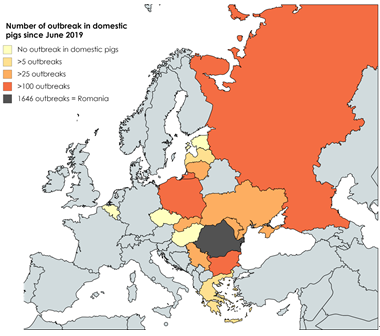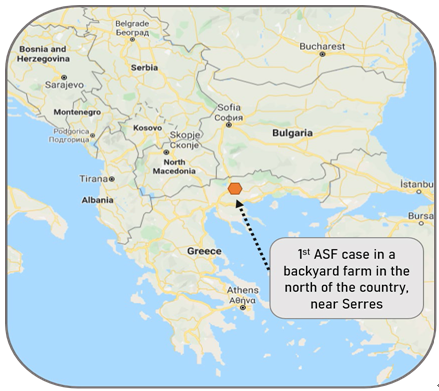全球的生猪和猪肉贸易让世界养猪大国高度互联,但也增加了外来疾病进入任何一个国家的风险。在当前非洲猪瘟肆虐全球的形势下,了解全球猪病变化形势,学习国外行之有效的疾病防控经验,才能‘师夷长技以自强’。
全球猪病监测报告将作为系列每月推出,希望能帮助养猪业和养猪企业评估风险、早期监测、做好预防、战胜疾病。
全球猪病监测报告2020年3月(上)
Swine Disease Global Surveillance Report, Mar. 2020(Part 1)
1. 欧洲食品安全局(EFSA)报告:欧洲委员会要求EFSA提供ASF流行病学的最新分析,总结可持续控制战略的关键发现和已知的不足之处。要点如下:
European Food Safety Authority (EFSA) report: The European Commission requested EFSA provide an updated analysis of the epidemiology of ASF. Key findings and identified gaps to inform sustainable control strategies are summarized. A few to note:
1.1 ASF的发展是渐进的、缓慢的,主要向西南方向蔓延。
ASF has been progressively, but slowly, expanding mainly in a southwesterly direction.
1.2 在所有受影响的国家都有证据表明该病毒的迁移是人为介导的,ASFV进入比利时、捷克共和国、和波兰西部就是最明显的例子。
There is evidence in all affected countries that is suggestive of human-mediated translocation of the virus. The most obvious examples of this include the introduction of ASFV into Belgium, Czech Republi and western Poland.
1.3 目前,没有证据表明大型围栏对野猪的围堵是有效的。目前一些大规模围栏正在建设中,但它们阻隔野猪数量的效果还需评估。
Currently, there is no evidence that large fences have been effective for the containment of wild suids. Some new large-scale fences are under construction, and their effectiveness in separating wild boar populations will need to be evaluated in the future.
2. 希腊证实了首例非洲猪瘟(ASF)病例:该病是在距离保加利亚边境不到50英里的一个后院农场发现的。
Greece confirms the first case of African swine fever (ASF): The disease was found in a backyard farm less than 50 miles from the border with Bulgaria.
3. 缅甸出现新的ASF疫情:缅甸最新报告该国北部出现新的疫情,该疫情距离缅甸第一例病例的爆发将近5个月。
New ASF outbreak in Myanmar: After almost five months since its first case Maynmar reported new outbreaks in the north of the country.
4. ASF在菲律宾的蔓延:菲律宾政府下令扑杀了Davao Occidental省仅剩的10万头生猪。
Expansion in the Philippines: Government ordered the culling of what remained of the 100,000 hogs in Davao occidental province.
5. 口蹄疫(FMD)在肯尼亚爆发:肯尼亚北部地区确认暴发了FMD。
Foot-and-mouth disease (FMD) outbreak in Kenya: An outbreak of FMD was confirmed in the northern part of the country.
2018-2019 欧洲的ASF经验和教训总结
ASF in Europe 2018-2019: Lessons Learned
欧洲食品安全局(EFSA)在欧盟发布了ASF流行病学分析(2018年11月至2019年12月)。
The European Food Safety Authority (EFSA) released epidemiological analyses of ASF in the European Union (Nov 2018-Dec 2019).
部分关键发现如下:
Some of the main findings are:
1. ASF的发展是渐进的,但发展缓慢,主要向西南方向扩展。
ASF has been progressively, but slowly, expanding mainly in a southwesterly direction.
2. 除了在捷克共和国(现已解决)、波兰西部和比利时的个别引进之外,所有受asf影响的地区基本上是相邻的。
All ASF-affected areas are essentially contiguous, except for isolated introductions in Czech Republic (now resolved), western Poland and Belgium.
3. 对已在野猪中发现该疾病超过两年的国家(波罗的海国家、波兰和罗马尼亚),结果证实了在ASF检测中存在季节性。野猪对ASF的呈报量冬、夏季最高,春季最低。在家养猪中,根据这些国家通报的疫情,只有一个夏季高峰是明显的。
In countries where the disease has been present in wild boar for more than t wo years (Baltic countries, Poland and Romania), results confirm the presence of seasonality in ASF detections. The number of notifications of ASF in wild boar were highest in winter and summer and lowest in spring. In domestic pigs, only a summer peak was evident based on notified outbreaks in these countries.
4. 报告分析了ASF在野猪群体中自然繁殖的速度。比利时、捷克共和国、爱沙尼亚、匈牙利、拉脱维亚、立陶宛和波兰的感染速度中值为2.9至11.7公里/年。
An analysis was performed to assess the speed of natural propagation of ASF in wild boar populations. The median velocity of infection in Belgium, Czech Republic, Estonia, Hungary, Latvia, Lithuania, and Poland was between 2.9 and 11.7 km/year.
5. 在所有受影响的国家都有证据表明该病毒的迁移是人为介导的,ASFV进入比利时、捷克共和国、和波兰西部就是最明显的例子。此外,对不太明显的事件进行的分析表明,人为介导的ASFV迁移仍然是导致野猪群内部和猪群之间发生ASFV迁移的一个非常重要的因素,其中,对东南部受影响地区的影响尤其大。
There is evidence in all affected countries thatis suggestive of human-mediated translocation of the virus. The most obviousexamples of this include the introduction of ASFV into Belgium, Czech Republic andwestern Poland. Moreover, the analysis of less obvious occurrences revealed thathuman-mediated translocation of ASFV remains a very important factor in contributingto the translocations of ASFV both within and between wild boar populations, ofparticular impact in the south-eastern affected region.
6. 识别家猪/野猪群体之间的关键风险因素是加强生物安全和其他风险缓解措施的一个关键目标。在这方面,我们结合2014 - 2019年爱沙尼亚野猪ASF发生情况的数据进行了分析。这些结果受2014年家猪业状况的影响尤其大,每增加一个单位的小农场猪密度(小农场动物/平方公里),观察到ASF阳性的野猪的概率就增加18倍。还有许多其他变量被确定为不显著的危险因素。(详情请见欧洲食品安全局报告)。
The identification of key risk factors at the domestic/wildlife interfacewith a view to strengthening biosecurity and other risk mitigation measures wasa key target of these efforts. In this regard, data of ASF occurrence in wildboar in Estonia, incorporating data from 2014 to 2019, was used for thisanalysis. These results were particularly influenced by the conditions of the domesticpig sector in 2014, presenting an 18-fold increase in the probability ofobserving an ASF-positive wild boar for each unit increase in the density of pigsin smallholdings per local administrative unit (animals in smallholdings/km2). Manyother variables were identified as non-significant risk factors. (Furtherdetails: EFSA report).

图1:自去年6月以来,欧洲国家的ASF暴发数量
Map 1. Number of ASF outbreaks in European countries since last June
7. 关于ASF发生的潜在风险因素,特别是ASF入侵罗马尼亚家猪场,商品场发生ASF的唯一重要风险因素是距离最近的家猪疫情的距离。
RegardingpotentialriskfactorsforASFoccurrencebutwithaparticularfocusonASFincursionindomesticpigholdingsinRomania,theonlysignificantriskfactorforASFoccurrenceincommercialherds was the distanceto the nearest domestic pigoutbreak.
8. 据报道,野生猪的数量已经急剧减少(高达80%),控制方案是通过直升机或通过诱捕和与狗的激烈驱猎相结合的方式来猎杀猪。也有报告显示,野猪数量会迅速恢复,在采取这些干预措施后的第二年恢复了77%。这些信息凸显了一个事实,即疾病控制的紧急干预措施(在当地实施的积极措施)与可持续的野猪数量管理相关的大规模长期管理不同,也不应与之混淆。
Drastic reduction (up to 80%) of feral pigpopulations has been reported with control programs in which pig hunting isconducted from a helicopter or through a combination of trapping and intense drivehunting with dogs. Rapid recovery of the population has been reported, up to 77%the year following these interventions. This highlights the fact that urgent interventionsfor disease control (i.e., locally implemented emergency measures) aredifferent from, and should not be confused with, long-term management at larger scale associatedwith sustainable population management.
边境围栏:是否可行?-比利时的经验
Fences: Yes or No? - The Belgian experienc
比利时使用围网作为控制战略的一部分,围网部署在重点爆发野猪ASF的地区(摘要,欧洲食品安全管理局报告)。到目前为止,这些措施已被证明在将ASFV控制在受影响地区和避免进一步传播方面是有效的。这一战略包括各种不同措施的组合,即分区化管理、死猪尸体清除处理、全面的饲喂禁令、特定的狩猎规定和根据各地区情况而采取的野猪清群的行动、一定程度上禁止猪群流通和伐木,以及建立一个同心圆围网。围网(高120厘米,网孔大小15×9×20厘米,未掩埋,未固定在地面上)有助于减缓ASF的蔓延,并可以在不产生野猪长距离迁移的风险的情况下实现分区化管理从而进行清群。
Belgium uses fences as part of the control strategydeployed in the focal outbreak of ASF in wild boar (summary, EFSA report). So far, the measures have proven effective in keeping ASFV within the affected area and avoidingfurther spread. This strategy has included a combination of different measures, namely zoning, carcass removal, a complete feeding ban, specific huntingregulations and depopulation actions depending on the zone, a partial ban of circulation and logging, and setting up a network of concentricfences. Fencing (120 cm high, mesh size 15 x 9 x 20 cm, unburied and not fixxedto the ground) contributed to the slowing down of ASF spread and allowed compartments to be created in which depopulation could be carried out withoutrisking long distance wild boar movements.
目前,没有证据表明大型围网对野猪的围堵是有效的。有一些大规模围网正在建设中,但它们阻隔野猪数量的效果还有待评估。
Currently, there is no evidence that large fences have been effective forthe containment of wild suids. Some new large-scale fences are under construction,and their effectiveness in separating wild boar populations will need to be evaluatedin the future.
由于受到多种因素的影响,ASF的情况在欧盟国家之间存在很大差异,这些因素包括家猪生产的性质(特别是后院养猪的比例)、地理因素(包括地形、自然屏障)和野猪群的特征。
The ASF situation varies substantially between EU countries, due tomultiple influences including the nature of domestic pig production (inparticular, the proportion of backyard holdings), geographic considerations(including topography, natural barriers) and the characteristics of the wild boarpopulation.
Remaining knowledge gaps -
在欧洲,关于ASF流行病学的知识存在重大空白,包括:
There are significant gaps in knowledge on the epidemiology of ASF in Europe, including:
1. 野猪与死猪尸体的接触率、群体间的接触率、病媒(包括昆虫) 或机械病媒在ASF传播中的潜在作用。
The contact rate between wild boar and carcasses, the contact rate between groups, and the potential role of vectors in ASF spread (including insects) or mechanical vectors.
2. 应制定有关家庭屠宰的法规,并制定适当的控制措施,以限制受感染肉类的流通。
Regulations should be developed for home slaughtering and appropriate controls enacted, to limit the circulation of infected meat.
3. 为了完善野猪种群控制策略,需要进一步研究,以便:
To improve wild boar population control strategies, further research is needed:
3.1 找出促进ASF在受影响地区持续数年的途径。
To clarify the pathways that facilitate ASF persistence in affected areas over a number of years.
3.2 明确在存在ASF感染情况下对血清阳性的解释,包括PCR阴性和抗体阳性的动物是否应作为ASF病例通报。
To clarify the interpretation of seropositivity in the context of ASF infection, including whether animals that test both PCR negative and Ab positive should be notified as an ASF case or not.
To clarify the ability of survivor animals to excrete or harbor the virus.
3.4 确定在目前没有感染证据的地区,一只PCR阳性野猪的流行病学意义。
To clarify the epidemiological significance of a single, PCR-positive wild boar in areas with no current evidence of infection.
To clarify the duration of colostral antibodies in piglets.
3.6 验证用以估计发现死亡的野猪的死亡时间的方法。
To validate methods to estimate carcass age (time since death) in found-dead wild boar.
3.7 找到在发现最后一个已知的感染动物/尸体后进行ASF净化的方法。
To define a pathway to ASF freedom following the detection of the last known infected animal/carcass.
希腊农业部官员于2020年2月6日向世界动物卫生组织报告,该国在该国北部的一个后院农场发现了首例ASF。受感染的养殖场位于希腊北部肯特里基马科多尼亚省的塞雷斯镇附近,靠近保加利亚(37.3英里)和北马其顿(地图2)边境。
Greece detected the first case of ASF at a backyard farm in the northern part of the country, agriculture ministry officials reported to the OIE on February 6, 2020. The infected finishing farm was confirmed positive near the town Serres, in the province Kentriki Makedonia, a region of northern Greece close to the border with Bulgaria (37.3 miles) and North Macedonia (Map 2).
该猪场有32头猪,其中一头死于非洲猪瘟。2月5日,国家参考实验室通过三种不同的诊断试验(实时定量PCR、ELISA抗原检测和间接免疫过氧化物酶检测(IPT))在一个后院猪场的死亡肥猪中确认了该疫情。自2月3日起,当局已根据怀疑情况采取了措施。
The farm had 32 pigs, of which one pig had died of ASF. The outbreak was confirmed by the National Reference Laboratory in a dead fattening pig in a backyard farm, using three different diagnostic tests (real-time PCR, ELISA for antigen detection and indirect immunoperoxidase test (IPT)) on February 5. Measures had been adopted in the framework of the suspicion since February 3 and, following the confirmation of the outbreak.
Map 2. Location of the ASF outbreak in Greece
根据欧洲疫情评估报告(DEFRA, UK)的最新信息,从2019年11月到2020年1月31日,保加利亚发生187例野猪ASF疫情。1月份的数据显示疫情高达105例,与之前月份(11月= 44;12月= 38日)相比有所增加。一些病例靠近目前无ASF的北马其顿和希腊边境,这两个国家已经处于高度警戒状态;去年12月,这两个国家被认定为9个巴尔干国家中ASF在一年内最有可能入境的国家(66-100%)。据此,希腊预测将会有ASF爆发,并在确诊该病毒之前加强了监测。
According to the latest updates of the European Outbreak Assessment report (DEFRA, UK), there have been 187 cases of ASF in wild boar in Bulgaria from November 2019 to January 31, 2020. The January count showed a peak of 105 compared to the previous month (November = 44; December = 38), which could suggest an increase in ASF circulation. Some cases were close to the borders of currently ASF- free North Macedonia and Greece, both of which were already on high alert; they had been identified last December, as two of the nine Balkan countries to have a very high chance (66-100%) of disease spread inside their borders within a year of introduction. Accordingly, Greece was expecting an ASF outbreak and had stepped up surveillance, ahead of confirmation of the virus in the country.
希腊国内消费的三分之一的猪肉来自本国,其余部分则依靠进口。2017年,该国约有74.4万头猪(粮农组织)。
Greece produces about a third of its domestic pork consumption and imports the rest. In 2017, the country had about 744,000 pigs (FAO).
该猪场周围3公里范围内的所有生猪都被扑杀。方圆10公里内的区域不允许有猪进入或离开,同时进行检测以追踪疾病的起源。来自塞雷斯县的所有猪产品,包括肉类、食品、精液和鸡蛋、厨具和其他相关废弃物都已禁止流出。此外,塞雷斯地区的兽医中心、警局、港口和政府当局都处于警戒状态。
All farmed pigs in an area of 3km around the farm were culled. Pigs were not allowed to enter or exit areas within a 10km radius, while tests were being conducted to trace the origin of the disease. Exports of all swine products including meat, food, sperm and eggs, utensils and other related waste from the Serres prefecture was banned. In addition, Serres prefecture veterinarian centers, police, port and government authorities have been placed on alert.
2019年,希腊向欧洲委员会提交了一份将于2020年实施的ASF控制和净化计划。经过评估,欧盟委员会于2020年1月通过了一项拨款决定,批准了该项目,并为该项目划拨了20.3万欧元的资金支持。
In 2019, Greece submitted to the Commission a program for control eradication of ASF to be implemented in 2020. After its evaluation, the Commission approved the program through a Grant Decision on January 2020 and allocated €203,000 of financial support for the program.
New ASF outbreak on a large commercial farm
保加利亚食品安全局(BFSA)报告说,在该国东北部寿门区Nikola Kozlevo村的一个商业农场爆发了ASF。
The Bulgarian Food Safety Authority (BFSA) has reported an outbreak of ASF in a commercial farm in the village of Nikola Kozlevo, Shoumen District (northeast of the country).
在此之前,希腊已有6个月未在大型商品场出现ASF疫情。位于索菲亚的国家参考实验室在一个存栏24000头猪的猪场确认了该疫情。
After six months without any new ASF outbreaks on large commercial farms, the National Reference Laboratory in Sofia confirmed the presence of the disease on a pig farm with 24,000 susceptible animals.


















